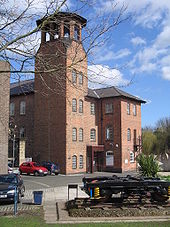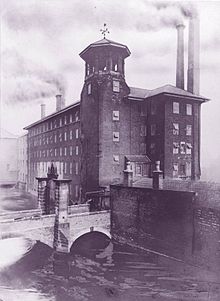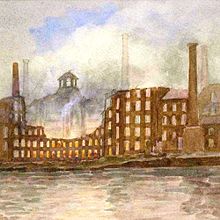- Derby Industrial Museum
-
Coordinates: 52°55′33″N 1°28′33″W / 52.925833°N 1.475833°W
Derby Silk Mill (Derby Industrial Museum) 
The museum and the River DerwentEstablished 1974 Location Derby, England Type Industrial museum Derby Silk Mill, formerly known as Derby Industrial Museum, is a museum of industry and history in Derby, England. The museum is housed in Lombe's Mill, a historic former silk mill which marks the southern end of the Derwent Valley Mills World Heritage Site. Between 1717 and 1721 George Sorocold[1] built Britain’s first mill for the Lombe brothers, beside the River Derwent. This mill was built to house machines for "doubling" or twisting silk into thread.
John Lombe copied the design for the machines used for spinning large quantities of silk, during a period spent in Italy, working within the Italian Silk Industry. This was possibly the first example of industrial espionage.
Traditionally the spinning wheel had been used for producing small quantities of silk thread at the homes of local spinsters, the new large, machines were capable of producing far greater quantities of silk and were to become serious competition for the Italians. These machines however required large buildings and a considerable power source. An undershot water wheel turned by the mill fleam on the west side of the new Silk Mill drove the massive spinning machines.
John Lombe died in 1722 under mysterious circumstances, and was believed to have been poisoned by an Italian assassin in retribution for stealing their trade secrets. His half brother, Sir Thomas Lombe Knt., died on 2 June 1739 leaving his estate to his widow and their two daughters.
Dame Elizabeth advertised the lease for sale in 1739, and the remaining 64 years of the lease were assigned to Richard Wilson junior of Leeds for £2,800.
Richard Wilson remained in Leeds leaving the running of the mill to his partners, William and Samuel Lloyd, both London merchants, with Thomas Bennet as salaried manager, taking a proportion of the profits.
A description of the mill by William Wilson dating from sometime between 1739 and 1753 has survived:
“ The original "Italian" works of five storeys high housed 26 Italian winding engines that spun the raw silk on each of the upper three floors whilst the lower two storeys contained eight spinning mills producing basic thread and four twist mills. ” These circular spinning machines (also known as 'throwing machines'), were the most significant innovation of the factory. Together with the single source of power (water), and the large size and organisation of the workforce for the period (200-400, according to contemporary sources), the total process of production from raw silk to fine quality thread has led the Lombes' silk mill to be described as the first successful use of the factory system in Britain.[2]
The Silk Mill was one of the tourist attractions of Derby and was visited by Boswell in September 1777. Not all the visitors were impressed by conditions. Torrington commented on the "heat, stinks and noise", whilst Fairholt in 1835 was appalled by the sickly appearance of the poor children. Foreign visitors also included the mill in their itinerary.
William Hutton was amongst the employees and he later recalled the long hours, low wages and beatings. Work only stopped in time of drought, extreme frost or problems with the silk supply, although unofficial holidays were taken during elections and Derby races in August 1748.
The partnership of Wilson and Lloyd ended in 1753 after acrimony and legal suits. Lloyd remained in possession of the building and machinery.
In 1765 Thomas Bennet bought the premises from Lloyd subject to a mortgage to the Wilson family but neglected the building during years of trade recession and competition from other mills in Derby and Cheshire.
Lamech Swift became the sub-tenant in 1780 paying an annual rent of £7 to the Corporation and £170 to Thomas Wilson, brother of Richard and William. Despite a row with the Corporation over repairs to the weirs in 1781, he remained in occupation until the lease expired in 1803.
The Corporation advertised the lease in 1803 to run for 60 years. The advertisement reveals that the "Italian works" was still used for throwing silk.
November 1833 saw the beginning of industrial unrest in Derby which led to the formation of the Grand National Trades Union in February 1834. This event predated the Tolpuddle Martyrs by several months. Taylor’s Silk Mill was not at the centre of the controversy although he was one of the employers who agreed not to employ any worker who was a union member. By the middle of April 1834 Taylor reported that two-thirds of his machinery was working and many of his former workers were applying for reinstatement. According to "The Derby Mercury" some of the former unionists were never able to find fresh employment in Derby. This event is commemorated by a march organised by the Derby Trades Union Council every year on the weekend before MayDay.
The Taylor family remained in occupation of the mill until 1865 when bankruptcy forced them to sell their machinery and lease. "The Derby Mercury" advertised several silk mills for sale that year and it were obvious that a general slump was hitting the industry. This took place four years before the Cobden Treaty with France which is said to have effectively destroyed the British silk industry.
The long connection with silk production ended in about 1908 when F.W. Hampshire and Company, the Chemists, moved into the premises to make fly papers and cough medicines. On 5 December 1910 at 5.00 am, fire broke out in the adjacent flour mill of Sowter Bothers and soon engulfed the Silk Mill. The mill's east wall fell into the river and the whole building was gutted. Great efforts were made by the Borough Fire Brigade and the Midland Railway Company who saved the shell of the tower and the outline of the doorways leading into the original five floors. These can still be seen today on the tower staircase. The building was rebuilt at the same height but with three storeys instead of five and remains that way today.
During the 1920s the building passed ownership to the Electricity Authority. They used it partly as stores, workshops and a canteen. Hidden from the road by the power station, the mill's existence was largely forgotten by the general public until the power station was demolished in 1970. It was then adapted for use as Derby’s long proposed Industrial Museum, which opened on 29 November 1974.
Closure and mothballing in 2011
Derby City Council closed the museum on 3 April 2011[3] in order to free funds for the redevelopment of the Silk Mill museum and other museums in the city. The Report of the Strategic Director of Neighbourhoods (Item 7 put before the Council Cabinet meeting held on the 26 October 2010) indicated that this would result in the loss of 8.6 full time jobs but would release £197,000 a year which would help mitigate the loss of "Renaissance Programme" funding. No date for the re-opening of the museum is given in the report,[4] although a period of two years has been reported.[5]
Sources
- ^ Whitehead, Bill (04 1999). "The Derby Lock-Out of 1833-34 and the Origins of the Labour Movement". http://reocities.com/CapitolHill/congress/1346/p0titlepage.htm. Retrieved 2011-05-26.
- ^ Lombe's Mill: An Exercise in Reconstruction, Industrial Archaeology Review, Anthony Calladine (1993)
- ^ "The Silk Mill". Derby City Council. http://www.derby.gov.uk/LeisureCulture/MuseumsGalleries/Derby_Industrial_Museum.htm. Retrieved 2010-05-26.
- ^ "Report of the Strategic Director of Neighbourhoods". Derby City Council. 2010-10-26. http://cmis.derby.gov.uk/CMISWebPublic/Binary.ashx?Document=16506. Retrieved 2011-01-04.
- ^ J Royston (2011-02-25). "Don't allow this valuable museum to be sacrificed". This Is Derbyshire. http://www.thisisderbyshire.co.uk/news/Don-t-allow-valuable-museum-sacrificed/article-3268056-detail/article.html. Retrieved 2011-05-26.
Sources of information:
- Derby Industrial Museum, Derby Evening Telegraph and Derby Library Service. (1999)
- The Derby Lock-Out and the origins of the labour movement Bill Whitehead (2001)
- Struck out! Derby in Crisis: the Silk Mill Lock-Out 1833-4, Derby, H. E. Butterton (1997)
External links
- "The Silk Mill". Derby City Council. http://www.derby.gov.uk/LeisureCulture/MuseumsGalleries/Derby_Industrial_Museum.htm. Retrieved 2010-05-26.
Derby Museum and Art Gallery Artists Francis Leggatt Chantrey · Ernest Ellis Clark · W. J. Coffee · Derby Sketching Club · Harold Gresley · Count Holtzendorff · Alfred John Keene · Henry Lark Pratt · David Payne · Ronald Pope · Samuel Rayner · Louise Rayner · Thomas Smith · Ernest Townsend · George Turner · Joseph Wright of DerbyGeology Ashford Black Marble · John Farey · William Martin · Matlockite · John Mawe · White Watson · John WhitehurstDecorative arts Bonnie Prince Charlie RoomMilitary history 9th/12th Royal Lancers · William Goate · Robert Kells · Francis O. Grenfell · David Rushe · David Spence · Gen. Johnson Saving Officer from TomahawkNatural history Paintings & drawings Richard Arkwright · Orrery · Indian Widow · Romeo and Juliet · Miravan · Alchemist · Virgil's Tomb · Blacksmith's Shop · Earthstopper · A Philosopher by Lamplight · Samuel Ward · Captive · Captive King · Dovedale · Thomas and Ann Borrow · VesuviasPorcelain Chelsea porcelain factory · Derby porcelain · Royal Crown Derby · Pinxton Porcelain · André Planché · William Billingsley · William DuesburyAncient Britain Creswellian culture · Derventio · Strutt's Park Roman fort · Derby Racecourse Roman settlement · Hanson Log Boat · Great Heathen Army · Heath Wood barrow cemetery · Codnor Castle · Duffield Castle · Icknield St. · The Street · The Long LaneScience & engineering Atlas Coelestis · Benjamin Vulliamy Whitehurst & Son sundial · QRpediaRelated OrganisationsAndrew Handyside & Co. · British Rail Research Division · Derby Philosophical Society · Derby Exhibition (1839)PeopleAlchmund · P.P.Burdett · D'Ewes Coke · Erasmus Darwin · 6th Duke of Devonshire · James Ferguson · R.K.Freeman · Alfred E. Goodey · Sir George Harpur Crewe · Llewellyn Jewitt · John Lombe · William Mundy · Joseph Pickford · 5th Earl Ferrers · George Sorocold · Joseph Strutt · Charles SylvesterDerby Silk Mill (Lombe's Mill) · Pickford's House Museum · Central Library Categories:- Grade II listed buildings in Derby
- History of the textile industry
- Industrial Revolution
- Industry museums in England
- Textile museums in the United Kingdom
- Museums established in 1974
- Museums in Derby
- Watermills in England
- Buildings and structures completed in 1721
- Collections of Derby Museum and Art Gallery
- Visitor attractions in Derby
Wikimedia Foundation. 2010.




